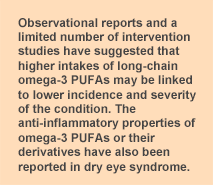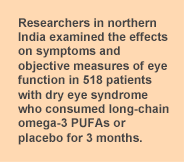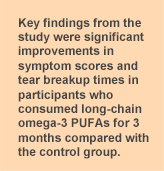
The rationale for exploring the potential benefits of long-chain omega-3 PUFAs (n-3 LC-PUFAs) in dry eye syndrome (dry eye) stems from their well known anti-inflammatory properties and from the reduced incidence of certain eye diseases among individuals who consume fish or these PUFAs. In 2005, an
epidemiological study reported that the consumption of tuna or higher amounts of n-3 LC-PUFAs was associated with a significantly lower risk of developing dry eye. Since then, various investigators have explored dietary supplementation with n-3 LC-PUFAs or mixtures containing these PUFAs plus n-6 PUFA, antioxidants and other substances in patients with dry eye. A small study in Japanese patients reported significant improvements in eye pain and objective measurements of the eyes and tears with
EPA-rich supplementation for 12 weeks. As described in the
December 2013 PUFA Newsletter, investigators in Spain reported that patients with clinically diagnosed meibomian gland dysfunction who consumed 1.3 g of DHA-rich n-3 LC-PUFAs daily for 3 months experienced
significant reductions in their subjective and objectively measured symptoms and tear levels of inflammatory mediators. These investigators have since reported that patients with dry eye who consumed a commercial
supplement containing DHA-rich n-3 LC-PUFAs, antioxidant vitamins and other nutrients, providing 1.5 g/day of n-3 LC-PUFAs (1.05 g DHA), for 12 weeks experienced a
significant reduction in symptoms, improved tolerance of contact lenses and decreased use of artificial tears. A multicenter study in France
reported that patients with dry eye who consumed a supplement with n-3 and n-6 PUFAs, vitamins and zinc for 3 months had significantly reduced numbers of human leukocyte antigen-DR positive cells, indicating a reduction in a conjunctival inflammatory marker, but symptoms did not improve. The anti-inflammatory pro-resolving derivatives of EPA and DHA,
resolvins E1 and D1, reduced leukotriene D4 in cultured rat goblet cells and halted the secretion of this inflammatory mediator. As
reviewed by Cortina and Bazan, DHA and the derivatives of EPA and DHA reduce the symptoms of dry eye in animal models, increase the regeneration of damaged corneal nerves and have strong anti-inflammatory effects in conditions associated with dry eye. Overall, only a handful of studies have examined the effects of n-3 LC-PUFAs in dry eye syndrome, many with
small numbers of participants and varying treatments and doses. To date, all have reported significant symptom improvements.

In this report, investigators from Ghaziabad, Uttar Pradesh, India, present the results of a randomized control trial using n-3 LC-PUFA supplements in 518 patients with dry eye syndrome. The investigators noted that this region in northern India has a dry, windy climate with high exposure to ultraviolet radiation, and diets devoid of n-3 LC-PUFAs, all of which favor the development of dry eye. Eligible patients who reported symptoms of dry eye were recruited from 2 eye centers and enrolled unless they had pre-existing ocular disease, a past history of herpetic eye disease, liver disease, diabetes, LASIK surgery or were taking tetracycline or corticosteroids. Other exclusions included pregnancy, HIV or hepatitis B and C, post-menopausal status or psychiatric disease. Participants discontinued topical medications and use of contact lenses prior to treatment. On average, participants were 39 years of age. Participants (268 females, 250 males) were randomly assigned to consume 1 g per day of EPA and DHA (ratio ~2:1) or a corn oil placebo for 3 months. Participants were evaluated and scored at baseline and after 3 months for frequency of symptoms and adequacy of tear production (Schirmer’s I test), tear breakup time (TBUT), ocular surface integrity (Rose Bengal score) and conjunctival impression cytology for cellular changes and goblet cell density. One eye from each patient was selected at random for evaluation. At each monthly visit, participants received a detailed ocular examination by an independent ophthalmologist for measurement of best corrected visual acuity, slit lamp examination and meibomian gland function.

After 3 months’ treatment, symptom scores improved in both the n-3 LC-PUFA and placebo groups, but the magnitude of the improvements was significantly greater in the n-3 LC-PUFA group (change in score, 2.02 ± 1.0 vs. 0.48 ± 0.2, active treatment and placebo, respectively). Likewise, the improvement in the Schirmer’s I test scores was significantly greater in the n-3 LC-PUFA group compared with the placebo group. The greatest difference in scores between the two groups was in the tear breakup time, which increased by 2.54 ± 2.34 in the n-3 LC-PUFA participants and by 0.13 ± 0.16 in the placebo group. These improvements reflected a reduction in the number of participants with the shortest breakup times (<5 sec) from 62 to 40 and an increase in those with the longest breakup times (>10.1 sec) from 28 to 89 participants. Scores for conjunctival impression cytology improved only in the n-3 LC-PUFA group. In summary, this study observed significant improvements in symptom scores and tear breakup times in patients treated with n-3 LC-PUFA supplements for 3 months compared with those who took the placebo capsules. That these results were observed in relatively young adults compared with other studies of dry eye in older adults, suggests that the effects of n-3 LC-PUFA consumption are independent of age. Most important, n-3 LC-PUFA consumption eases the discomfort of dry eye disease and might protect the eye from further injury and inflammation. Bhargava R, Kumar P, Kumar M, Mehra N, Mishra A. A randomized controlled trial of omega-3 fatty acids in dry eye syndrome.
In J Ophthalmol 2013;6:811-816. [
PubMed] Open Access.
Worth Noting Merle BM, Benilan P, Puche N, Bassols A, Declourt C, Souied E. Circulating omega-3 fatty acids and neovascular age-related macular degeneration.
Invest Ophthalmol Vis Sci 2014;55:2010-2019. [
PubMed]
 The rationale for exploring the potential benefits of long-chain omega-3 PUFAs (n-3 LC-PUFAs) in dry eye syndrome (dry eye) stems from their well known anti-inflammatory properties and from the reduced incidence of certain eye diseases among individuals who consume fish or these PUFAs. In 2005, an epidemiological study reported that the consumption of tuna or higher amounts of n-3 LC-PUFAs was associated with a significantly lower risk of developing dry eye. Since then, various investigators have explored dietary supplementation with n-3 LC-PUFAs or mixtures containing these PUFAs plus n-6 PUFA, antioxidants and other substances in patients with dry eye. A small study in Japanese patients reported significant improvements in eye pain and objective measurements of the eyes and tears with EPA-rich supplementation for 12 weeks. As described in the December 2013 PUFA Newsletter, investigators in Spain reported that patients with clinically diagnosed meibomian gland dysfunction who consumed 1.3 g of DHA-rich n-3 LC-PUFAs daily for 3 months experienced significant reductions in their subjective and objectively measured symptoms and tear levels of inflammatory mediators. These investigators have since reported that patients with dry eye who consumed a commercial supplement containing DHA-rich n-3 LC-PUFAs, antioxidant vitamins and other nutrients, providing 1.5 g/day of n-3 LC-PUFAs (1.05 g DHA), for 12 weeks experienced a significant reduction in symptoms, improved tolerance of contact lenses and decreased use of artificial tears. A multicenter study in France reported that patients with dry eye who consumed a supplement with n-3 and n-6 PUFAs, vitamins and zinc for 3 months had significantly reduced numbers of human leukocyte antigen-DR positive cells, indicating a reduction in a conjunctival inflammatory marker, but symptoms did not improve. The anti-inflammatory pro-resolving derivatives of EPA and DHA, resolvins E1 and D1, reduced leukotriene D4 in cultured rat goblet cells and halted the secretion of this inflammatory mediator. As reviewed by Cortina and Bazan, DHA and the derivatives of EPA and DHA reduce the symptoms of dry eye in animal models, increase the regeneration of damaged corneal nerves and have strong anti-inflammatory effects in conditions associated with dry eye. Overall, only a handful of studies have examined the effects of n-3 LC-PUFAs in dry eye syndrome, many with small numbers of participants and varying treatments and doses. To date, all have reported significant symptom improvements.
The rationale for exploring the potential benefits of long-chain omega-3 PUFAs (n-3 LC-PUFAs) in dry eye syndrome (dry eye) stems from their well known anti-inflammatory properties and from the reduced incidence of certain eye diseases among individuals who consume fish or these PUFAs. In 2005, an epidemiological study reported that the consumption of tuna or higher amounts of n-3 LC-PUFAs was associated with a significantly lower risk of developing dry eye. Since then, various investigators have explored dietary supplementation with n-3 LC-PUFAs or mixtures containing these PUFAs plus n-6 PUFA, antioxidants and other substances in patients with dry eye. A small study in Japanese patients reported significant improvements in eye pain and objective measurements of the eyes and tears with EPA-rich supplementation for 12 weeks. As described in the December 2013 PUFA Newsletter, investigators in Spain reported that patients with clinically diagnosed meibomian gland dysfunction who consumed 1.3 g of DHA-rich n-3 LC-PUFAs daily for 3 months experienced significant reductions in their subjective and objectively measured symptoms and tear levels of inflammatory mediators. These investigators have since reported that patients with dry eye who consumed a commercial supplement containing DHA-rich n-3 LC-PUFAs, antioxidant vitamins and other nutrients, providing 1.5 g/day of n-3 LC-PUFAs (1.05 g DHA), for 12 weeks experienced a significant reduction in symptoms, improved tolerance of contact lenses and decreased use of artificial tears. A multicenter study in France reported that patients with dry eye who consumed a supplement with n-3 and n-6 PUFAs, vitamins and zinc for 3 months had significantly reduced numbers of human leukocyte antigen-DR positive cells, indicating a reduction in a conjunctival inflammatory marker, but symptoms did not improve. The anti-inflammatory pro-resolving derivatives of EPA and DHA, resolvins E1 and D1, reduced leukotriene D4 in cultured rat goblet cells and halted the secretion of this inflammatory mediator. As reviewed by Cortina and Bazan, DHA and the derivatives of EPA and DHA reduce the symptoms of dry eye in animal models, increase the regeneration of damaged corneal nerves and have strong anti-inflammatory effects in conditions associated with dry eye. Overall, only a handful of studies have examined the effects of n-3 LC-PUFAs in dry eye syndrome, many with small numbers of participants and varying treatments and doses. To date, all have reported significant symptom improvements.  In this report, investigators from Ghaziabad, Uttar Pradesh, India, present the results of a randomized control trial using n-3 LC-PUFA supplements in 518 patients with dry eye syndrome. The investigators noted that this region in northern India has a dry, windy climate with high exposure to ultraviolet radiation, and diets devoid of n-3 LC-PUFAs, all of which favor the development of dry eye. Eligible patients who reported symptoms of dry eye were recruited from 2 eye centers and enrolled unless they had pre-existing ocular disease, a past history of herpetic eye disease, liver disease, diabetes, LASIK surgery or were taking tetracycline or corticosteroids. Other exclusions included pregnancy, HIV or hepatitis B and C, post-menopausal status or psychiatric disease. Participants discontinued topical medications and use of contact lenses prior to treatment. On average, participants were 39 years of age. Participants (268 females, 250 males) were randomly assigned to consume 1 g per day of EPA and DHA (ratio ~2:1) or a corn oil placebo for 3 months. Participants were evaluated and scored at baseline and after 3 months for frequency of symptoms and adequacy of tear production (Schirmer’s I test), tear breakup time (TBUT), ocular surface integrity (Rose Bengal score) and conjunctival impression cytology for cellular changes and goblet cell density. One eye from each patient was selected at random for evaluation. At each monthly visit, participants received a detailed ocular examination by an independent ophthalmologist for measurement of best corrected visual acuity, slit lamp examination and meibomian gland function.
In this report, investigators from Ghaziabad, Uttar Pradesh, India, present the results of a randomized control trial using n-3 LC-PUFA supplements in 518 patients with dry eye syndrome. The investigators noted that this region in northern India has a dry, windy climate with high exposure to ultraviolet radiation, and diets devoid of n-3 LC-PUFAs, all of which favor the development of dry eye. Eligible patients who reported symptoms of dry eye were recruited from 2 eye centers and enrolled unless they had pre-existing ocular disease, a past history of herpetic eye disease, liver disease, diabetes, LASIK surgery or were taking tetracycline or corticosteroids. Other exclusions included pregnancy, HIV or hepatitis B and C, post-menopausal status or psychiatric disease. Participants discontinued topical medications and use of contact lenses prior to treatment. On average, participants were 39 years of age. Participants (268 females, 250 males) were randomly assigned to consume 1 g per day of EPA and DHA (ratio ~2:1) or a corn oil placebo for 3 months. Participants were evaluated and scored at baseline and after 3 months for frequency of symptoms and adequacy of tear production (Schirmer’s I test), tear breakup time (TBUT), ocular surface integrity (Rose Bengal score) and conjunctival impression cytology for cellular changes and goblet cell density. One eye from each patient was selected at random for evaluation. At each monthly visit, participants received a detailed ocular examination by an independent ophthalmologist for measurement of best corrected visual acuity, slit lamp examination and meibomian gland function.  After 3 months’ treatment, symptom scores improved in both the n-3 LC-PUFA and placebo groups, but the magnitude of the improvements was significantly greater in the n-3 LC-PUFA group (change in score, 2.02 ± 1.0 vs. 0.48 ± 0.2, active treatment and placebo, respectively). Likewise, the improvement in the Schirmer’s I test scores was significantly greater in the n-3 LC-PUFA group compared with the placebo group. The greatest difference in scores between the two groups was in the tear breakup time, which increased by 2.54 ± 2.34 in the n-3 LC-PUFA participants and by 0.13 ± 0.16 in the placebo group. These improvements reflected a reduction in the number of participants with the shortest breakup times (<5 sec) from 62 to 40 and an increase in those with the longest breakup times (>10.1 sec) from 28 to 89 participants. Scores for conjunctival impression cytology improved only in the n-3 LC-PUFA group. In summary, this study observed significant improvements in symptom scores and tear breakup times in patients treated with n-3 LC-PUFA supplements for 3 months compared with those who took the placebo capsules. That these results were observed in relatively young adults compared with other studies of dry eye in older adults, suggests that the effects of n-3 LC-PUFA consumption are independent of age. Most important, n-3 LC-PUFA consumption eases the discomfort of dry eye disease and might protect the eye from further injury and inflammation. Bhargava R, Kumar P, Kumar M, Mehra N, Mishra A. A randomized controlled trial of omega-3 fatty acids in dry eye syndrome. In J Ophthalmol 2013;6:811-816. [PubMed] Open Access. Worth Noting Merle BM, Benilan P, Puche N, Bassols A, Declourt C, Souied E. Circulating omega-3 fatty acids and neovascular age-related macular degeneration. Invest Ophthalmol Vis Sci 2014;55:2010-2019. [PubMed]
After 3 months’ treatment, symptom scores improved in both the n-3 LC-PUFA and placebo groups, but the magnitude of the improvements was significantly greater in the n-3 LC-PUFA group (change in score, 2.02 ± 1.0 vs. 0.48 ± 0.2, active treatment and placebo, respectively). Likewise, the improvement in the Schirmer’s I test scores was significantly greater in the n-3 LC-PUFA group compared with the placebo group. The greatest difference in scores between the two groups was in the tear breakup time, which increased by 2.54 ± 2.34 in the n-3 LC-PUFA participants and by 0.13 ± 0.16 in the placebo group. These improvements reflected a reduction in the number of participants with the shortest breakup times (<5 sec) from 62 to 40 and an increase in those with the longest breakup times (>10.1 sec) from 28 to 89 participants. Scores for conjunctival impression cytology improved only in the n-3 LC-PUFA group. In summary, this study observed significant improvements in symptom scores and tear breakup times in patients treated with n-3 LC-PUFA supplements for 3 months compared with those who took the placebo capsules. That these results were observed in relatively young adults compared with other studies of dry eye in older adults, suggests that the effects of n-3 LC-PUFA consumption are independent of age. Most important, n-3 LC-PUFA consumption eases the discomfort of dry eye disease and might protect the eye from further injury and inflammation. Bhargava R, Kumar P, Kumar M, Mehra N, Mishra A. A randomized controlled trial of omega-3 fatty acids in dry eye syndrome. In J Ophthalmol 2013;6:811-816. [PubMed] Open Access. Worth Noting Merle BM, Benilan P, Puche N, Bassols A, Declourt C, Souied E. Circulating omega-3 fatty acids and neovascular age-related macular degeneration. Invest Ophthalmol Vis Sci 2014;55:2010-2019. [PubMed]

